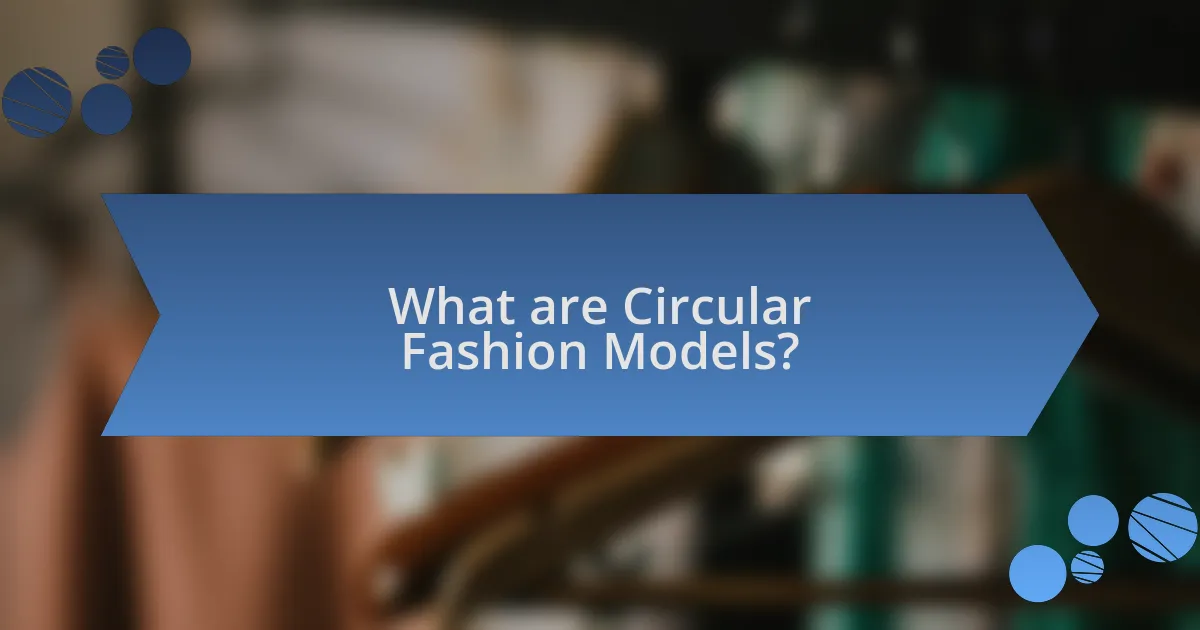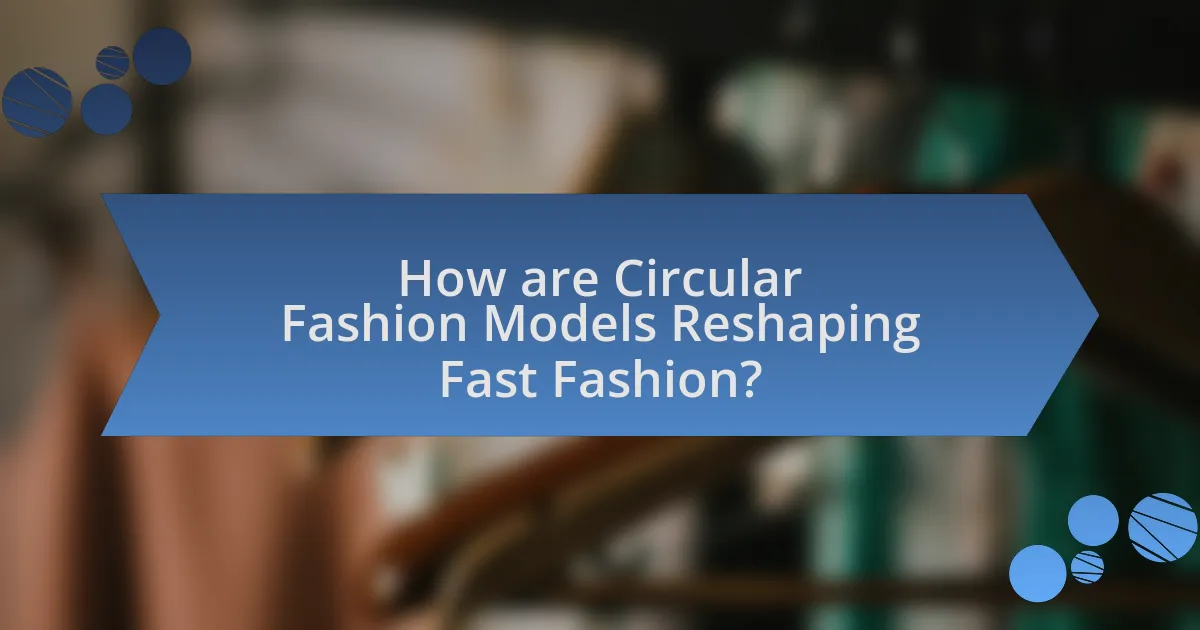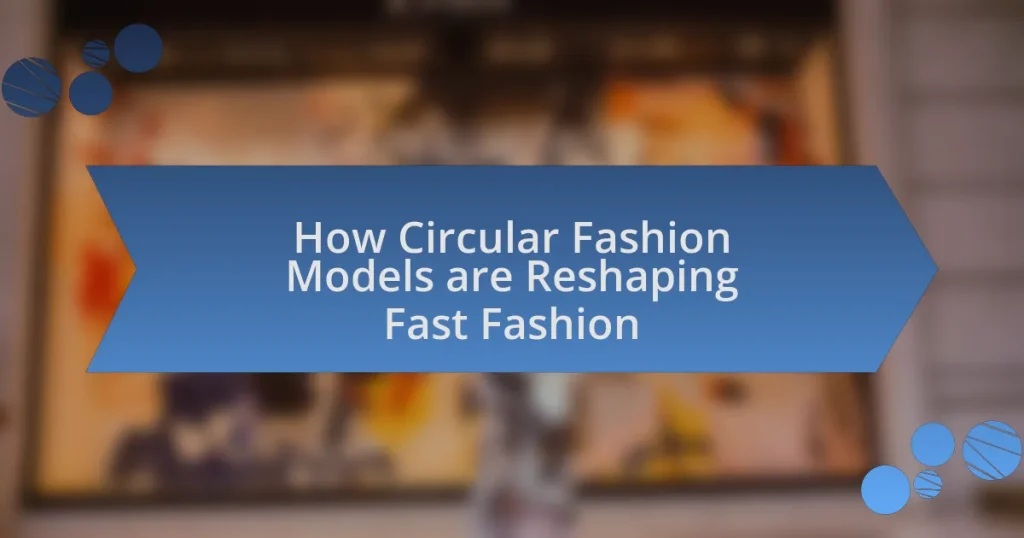Circular fashion models represent a sustainable approach to clothing production and consumption, emphasizing longevity, reuse, and recycling to minimize waste and environmental impact. This article explores how these models differ from traditional fast fashion practices, highlighting principles such as design for longevity and resource efficiency. It examines the growing popularity of circular fashion driven by consumer awareness and demand for sustainability, as well as the challenges fast fashion brands face in adapting to these models. Additionally, the article discusses the role of technology, innovation, and consumer education in promoting circular practices, ultimately illustrating how circular fashion is reshaping the fast fashion industry.

What are Circular Fashion Models?
Circular fashion models are sustainable approaches to clothing production and consumption that prioritize the longevity, reuse, and recycling of garments. These models aim to minimize waste and reduce the environmental impact of the fashion industry by promoting practices such as upcycling, rental services, and take-back schemes. For instance, a report by the Ellen MacArthur Foundation highlights that transitioning to a circular economy in fashion could reduce greenhouse gas emissions by 44% by 2030, demonstrating the potential of these models to reshape the industry.
How do Circular Fashion Models differ from traditional fashion models?
Circular fashion models prioritize sustainability and resource efficiency, contrasting with traditional fashion models that often emphasize fast production and consumption. Circular fashion focuses on designing products for longevity, reuse, and recycling, aiming to minimize waste and environmental impact. In contrast, traditional fashion typically follows a linear model, where garments are produced, used, and discarded, contributing to significant waste and pollution. This shift towards circularity is supported by research indicating that the fashion industry is responsible for 10% of global carbon emissions, highlighting the urgent need for sustainable practices.
What principles define Circular Fashion Models?
Circular fashion models are defined by principles such as design for longevity, resource efficiency, and closed-loop systems. These principles emphasize creating garments that are durable and timeless, minimizing waste through efficient use of materials, and ensuring that products can be recycled or repurposed at the end of their life cycle. For instance, the Ellen MacArthur Foundation highlights that circular fashion aims to keep products, materials, and resources in use for as long as possible, thereby reducing environmental impact and promoting sustainability in the fashion industry.
How do Circular Fashion Models promote sustainability?
Circular fashion models promote sustainability by prioritizing the reuse, recycling, and upcycling of materials, which significantly reduces waste and resource consumption. These models encourage a closed-loop system where products are designed for longevity and can be easily disassembled for recycling, thus minimizing the environmental impact associated with traditional linear fashion models. For instance, the Ellen MacArthur Foundation reports that transitioning to a circular economy in fashion could reduce global carbon emissions by 44% by 2030. This shift not only conserves resources but also fosters a more sustainable consumption pattern among consumers, ultimately leading to a more responsible fashion industry.
Why are Circular Fashion Models gaining popularity?
Circular fashion models are gaining popularity due to their sustainable approach that minimizes waste and promotes resource efficiency. This shift is driven by increasing consumer awareness of environmental issues, with a 2021 McKinsey report indicating that 67% of consumers consider sustainability when making fashion purchases. Additionally, brands are adopting circular practices to meet regulatory pressures and consumer demand for transparency, leading to a significant rise in circular initiatives within the fashion industry.
What consumer trends are driving the shift towards Circular Fashion?
The consumer trends driving the shift towards Circular Fashion include increasing environmental awareness, demand for sustainable products, and a preference for ethical consumption. Consumers are increasingly concerned about the environmental impact of fast fashion, with studies indicating that 66% of global consumers are willing to pay more for sustainable brands. Additionally, the rise of second-hand shopping and clothing rental services reflects a growing interest in reducing waste and extending the lifecycle of garments. This shift is further supported by social media, where influencers promote sustainable fashion choices, encouraging consumers to adopt circular practices.
How do Circular Fashion Models address environmental concerns?
Circular fashion models address environmental concerns by promoting the reuse, recycling, and sustainable production of clothing, which significantly reduces waste and resource consumption. These models aim to extend the lifecycle of garments through practices such as upcycling and rental services, thereby minimizing the environmental impact associated with fast fashion. For instance, the Ellen MacArthur Foundation reports that the fashion industry is responsible for 10% of global carbon emissions, and circular practices can help reduce this by encouraging the use of renewable resources and reducing landfill contributions. By shifting from a linear “take-make-dispose” model to a circular approach, the fashion industry can mitigate pollution and conserve natural resources, ultimately leading to a more sustainable ecosystem.

How are Circular Fashion Models Reshaping Fast Fashion?
Circular fashion models are reshaping fast fashion by promoting sustainability through the reuse, recycling, and upcycling of materials, which reduces waste and resource consumption. These models encourage brands to design products with a lifecycle approach, emphasizing durability and the ability to be repurposed. For instance, companies like H&M and Zara are integrating circular practices by launching take-back programs and using recycled materials in their collections, which aligns with the growing consumer demand for environmentally responsible fashion. This shift not only mitigates the environmental impact of fast fashion but also drives innovation in production processes, leading to a more sustainable industry overall.
What impact do Circular Fashion Models have on fast fashion brands?
Circular fashion models significantly challenge fast fashion brands by promoting sustainability and reducing waste. These models encourage brands to adopt practices such as recycling, upcycling, and rental services, which directly counteract the traditional fast fashion approach of rapid production and disposal. For instance, a report by McKinsey & Company indicates that the circular economy could generate $4.5 trillion in economic benefits by 2030, highlighting the financial incentive for fast fashion brands to transition towards more sustainable practices. As consumer awareness of environmental issues grows, fast fashion brands face increasing pressure to integrate circular principles, which can lead to enhanced brand loyalty and market competitiveness.
How are fast fashion brands adapting to Circular Fashion Models?
Fast fashion brands are adapting to Circular Fashion Models by implementing strategies such as recycling programs, sustainable material sourcing, and take-back schemes. For instance, brands like H&M and Zara have introduced garment collection initiatives that encourage customers to return used clothing for recycling or repurposing. According to a 2021 report by McKinsey & Company, the global fashion industry is projected to shift towards circularity, with 30% of brands already investing in sustainable practices. This shift not only reduces waste but also aligns with consumer demand for environmentally responsible products, demonstrating a significant transformation in the fast fashion sector.
What challenges do fast fashion brands face in implementing Circular Fashion Models?
Fast fashion brands face significant challenges in implementing Circular Fashion Models, primarily due to their existing business models that prioritize rapid production and consumption. These brands often struggle with supply chain complexities, as transitioning to circular systems requires rethinking sourcing, manufacturing, and distribution processes to minimize waste and promote recycling. Additionally, consumer behavior poses a challenge; many customers are accustomed to low prices and quick turnover, making it difficult to shift towards sustainable practices that may involve higher costs and longer product lifecycles.
Moreover, regulatory hurdles can impede progress, as existing laws may not support circular initiatives or may require extensive compliance efforts. Financial constraints also play a role, as investing in new technologies and processes for circularity can be costly, and fast fashion brands may be hesitant to allocate resources away from their traditional profit-driven models. According to a report by McKinsey & Company, the fashion industry must reduce its greenhouse gas emissions by 1.1 billion tons by 2030 to align with climate goals, highlighting the urgency for fast fashion brands to adapt but also the scale of the challenge they face.
How do Circular Fashion Models influence consumer behavior?
Circular fashion models significantly influence consumer behavior by promoting sustainable purchasing decisions and encouraging a shift towards valuing longevity over disposability. These models, which emphasize recycling, upcycling, and the use of sustainable materials, lead consumers to prioritize brands that align with their environmental values. Research indicates that 66% of global consumers are willing to pay more for sustainable brands, demonstrating a clear preference for products that contribute to a circular economy. This shift in consumer behavior is further supported by the rise of second-hand markets and rental services, which reflect a growing acceptance of shared ownership and reduced consumption.
What changes in purchasing habits are observed among consumers?
Consumers are increasingly prioritizing sustainability in their purchasing habits. This shift is evidenced by a growing preference for eco-friendly products, with 66% of global consumers willing to pay more for sustainable brands, according to a 2021 Nielsen report. Additionally, there is a notable rise in second-hand shopping, as the resale market is projected to reach $64 billion by 2024, reflecting a significant change in consumer attitudes towards ownership and waste. This trend indicates that consumers are not only seeking to reduce their environmental impact but are also embracing circular fashion models that promote reuse and recycling.
How does consumer education play a role in the adoption of Circular Fashion Models?
Consumer education is crucial for the adoption of Circular Fashion Models as it empowers individuals to make informed choices about sustainable practices. Educated consumers are more likely to understand the environmental impact of their purchases, leading to increased demand for circular products that prioritize reuse, recycling, and sustainability. Research indicates that consumers who are aware of the benefits of circular fashion, such as reduced waste and resource conservation, are more inclined to support brands that implement these models. For instance, a study by the Ellen MacArthur Foundation highlights that consumer awareness can significantly influence purchasing behavior, with 66% of consumers willing to pay more for sustainable brands. This demonstrates that effective consumer education can drive the transition towards circular fashion by fostering a culture of sustainability and responsible consumption.

What are the key components of Circular Fashion Models?
The key components of Circular Fashion Models include design for longevity, resource efficiency, waste reduction, and closed-loop systems. Design for longevity emphasizes creating durable products that withstand wear and tear, thereby extending their lifecycle. Resource efficiency focuses on utilizing sustainable materials and minimizing energy consumption during production. Waste reduction involves strategies to minimize textile waste through recycling and upcycling initiatives. Closed-loop systems aim to reclaim and repurpose materials at the end of a product’s life, ensuring that resources are continuously cycled back into the production process. These components collectively contribute to a more sustainable fashion industry by reducing environmental impact and promoting responsible consumption.
How do recycling and upcycling fit into Circular Fashion Models?
Recycling and upcycling are integral components of Circular Fashion Models as they promote the reuse of materials and reduce waste. Recycling involves processing used materials to create new products, thereby minimizing the need for virgin resources and decreasing environmental impact. For instance, the Global Fashion Agenda reports that recycling can significantly lower greenhouse gas emissions associated with textile production. Upcycling, on the other hand, transforms waste materials into new products of higher value, fostering creativity and sustainability. According to a study by the Ellen MacArthur Foundation, upcycling can extend the lifecycle of garments, reducing the overall consumption of new textiles. Together, these practices support the principles of Circular Fashion by closing the loop in the fashion supply chain, encouraging sustainable consumption, and mitigating the negative effects of fast fashion.
What processes are involved in recycling fashion items?
Recycling fashion items involves several key processes: collection, sorting, processing, and resale or repurposing. Initially, collection occurs through donation bins, retail take-back programs, or recycling centers where consumers drop off unwanted clothing. Following collection, sorting takes place, where items are categorized based on material type, condition, and resale potential. This step is crucial as it determines the subsequent processing method.
Processing involves transforming the sorted items into new materials or products. For instance, textiles can be shredded and re-spun into new fibers, or they can be upcycled into different fashion items. Finally, the recycled materials are either sold as raw materials to manufacturers or directly transformed into new fashion products, thus completing the cycle. According to the Ellen MacArthur Foundation, recycling can significantly reduce waste and resource consumption in the fashion industry, highlighting its importance in promoting sustainable practices.
How does upcycling contribute to sustainability in fashion?
Upcycling contributes to sustainability in fashion by transforming waste materials into new products, thereby reducing the demand for virgin resources. This process minimizes textile waste, as it repurposes discarded clothing and materials that would otherwise end up in landfills. According to the Ellen MacArthur Foundation, the fashion industry is responsible for 92 million tons of waste annually, highlighting the significant impact of upcycling in mitigating this issue. By extending the lifecycle of garments and promoting resource efficiency, upcycling supports a circular economy, which is essential for sustainable fashion practices.
What role do technology and innovation play in Circular Fashion Models?
Technology and innovation are crucial in Circular Fashion Models as they enable the design, production, and recycling processes to minimize waste and maximize resource efficiency. Advanced technologies such as 3D printing and digital design allow for on-demand production, reducing overproduction and excess inventory. Innovations in materials, like biodegradable fabrics and recycled textiles, contribute to sustainable sourcing and reduce environmental impact. Furthermore, data analytics and blockchain technology enhance transparency in supply chains, allowing consumers to make informed choices and fostering accountability among brands. These technological advancements collectively support the transition towards a circular economy in fashion, where products are designed for longevity and recyclability, ultimately reshaping the fast fashion industry.
How are digital platforms facilitating Circular Fashion Models?
Digital platforms are facilitating Circular Fashion Models by enabling the sharing, resale, and recycling of clothing through user-friendly interfaces and community engagement. These platforms, such as Depop and Poshmark, allow consumers to buy and sell second-hand items, thereby extending the lifecycle of garments and reducing waste. According to a report by the Ellen MacArthur Foundation, the resale market is projected to grow to $64 billion by 2024, highlighting the increasing consumer interest in sustainable fashion practices. Additionally, digital platforms often incorporate features that promote transparency in sourcing and production, further supporting circularity by informing consumers about the environmental impact of their purchases.
What innovations are emerging in materials and production methods?
Innovations in materials and production methods include the development of biodegradable textiles, recycled fibers, and 3D printing technologies. Biodegradable textiles, such as those made from organic cotton or hemp, reduce environmental impact by decomposing naturally. Recycled fibers, derived from post-consumer waste like plastic bottles, are increasingly used in fashion, with brands like Adidas incorporating them into their products, demonstrating a shift towards sustainability. Additionally, 3D printing allows for on-demand production, minimizing waste and enabling customization, as seen in companies like Unmade, which utilize this technology to create unique garments. These advancements collectively contribute to the circular fashion model by promoting resource efficiency and reducing waste in the fast fashion industry.
What best practices can brands adopt to implement Circular Fashion Models?
Brands can adopt several best practices to implement Circular Fashion Models, including designing for longevity, utilizing sustainable materials, and establishing take-back programs. Designing for longevity involves creating products that are durable and timeless, which reduces the frequency of purchases and waste. Utilizing sustainable materials, such as organic cotton or recycled polyester, minimizes environmental impact and resource depletion. Establishing take-back programs encourages consumers to return used items for recycling or refurbishment, thereby extending the lifecycle of products. These practices are supported by research indicating that circular fashion can significantly reduce waste and resource consumption, aligning with sustainability goals in the fashion industry.
How can brands effectively communicate their Circular Fashion initiatives to consumers?
Brands can effectively communicate their Circular Fashion initiatives to consumers by utilizing transparent messaging that highlights sustainability practices and the lifecycle of products. This approach includes sharing detailed information about materials used, production processes, and end-of-life options for garments, which fosters trust and engagement. For instance, brands like Patagonia and Eileen Fisher provide insights into their supply chains and recycling programs, demonstrating their commitment to environmental responsibility. Research indicates that 66% of consumers are willing to pay more for sustainable brands, underscoring the importance of clear communication in driving consumer interest and loyalty.
What partnerships can enhance the effectiveness of Circular Fashion Models?
Collaborations between fashion brands, recycling companies, and technology firms can significantly enhance the effectiveness of Circular Fashion Models. Fashion brands can partner with recycling companies to ensure that materials are properly reclaimed and reused, thereby reducing waste. For instance, H&M has collaborated with the textile recycling company I:CO to facilitate garment collection and recycling. Additionally, partnerships with technology firms can drive innovation in sustainable materials and supply chain transparency, as seen in collaborations like that of Adidas with Parley for the Oceans, which focuses on creating products from recycled ocean plastic. These strategic alliances not only improve resource efficiency but also promote consumer awareness and engagement in sustainable practices.















